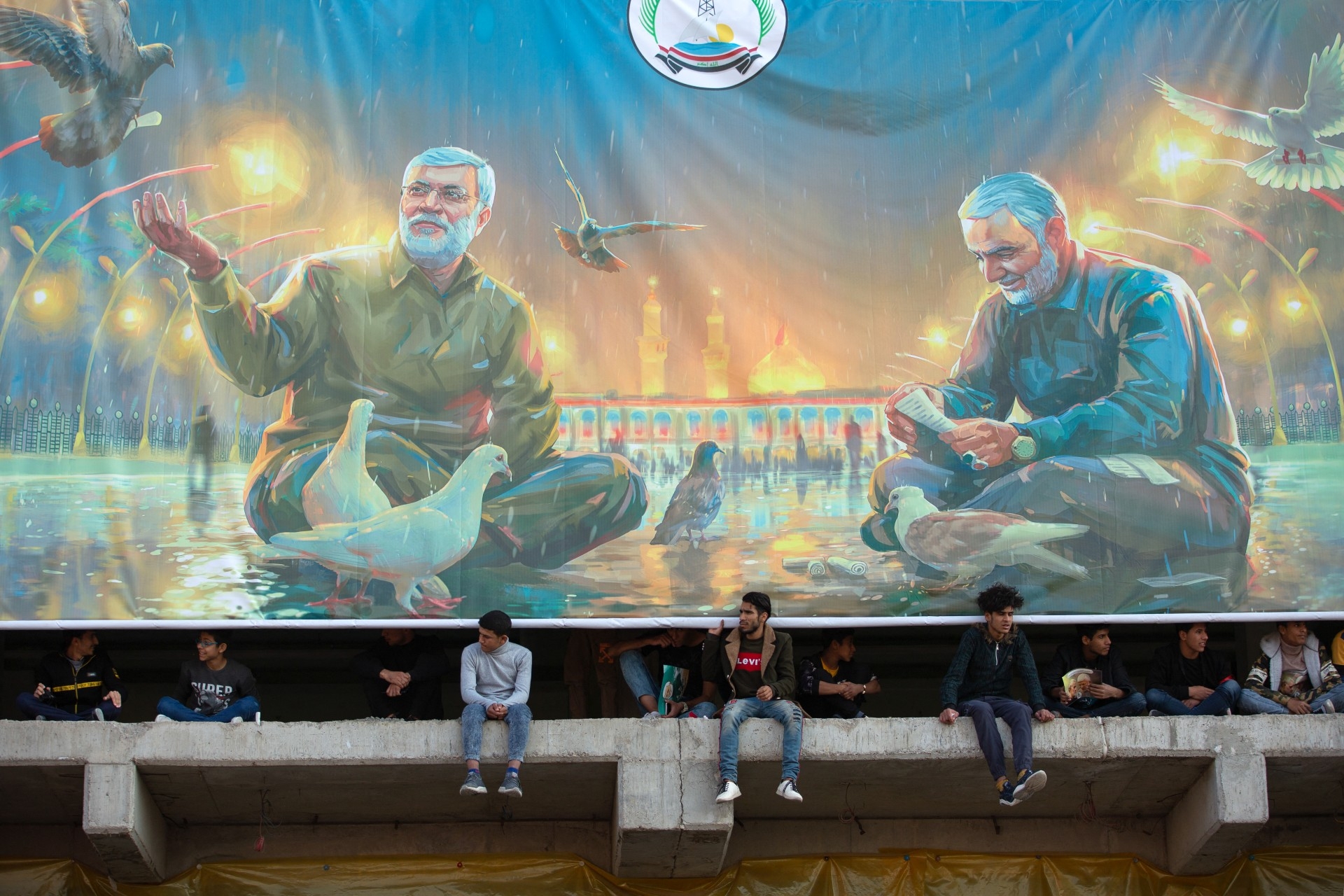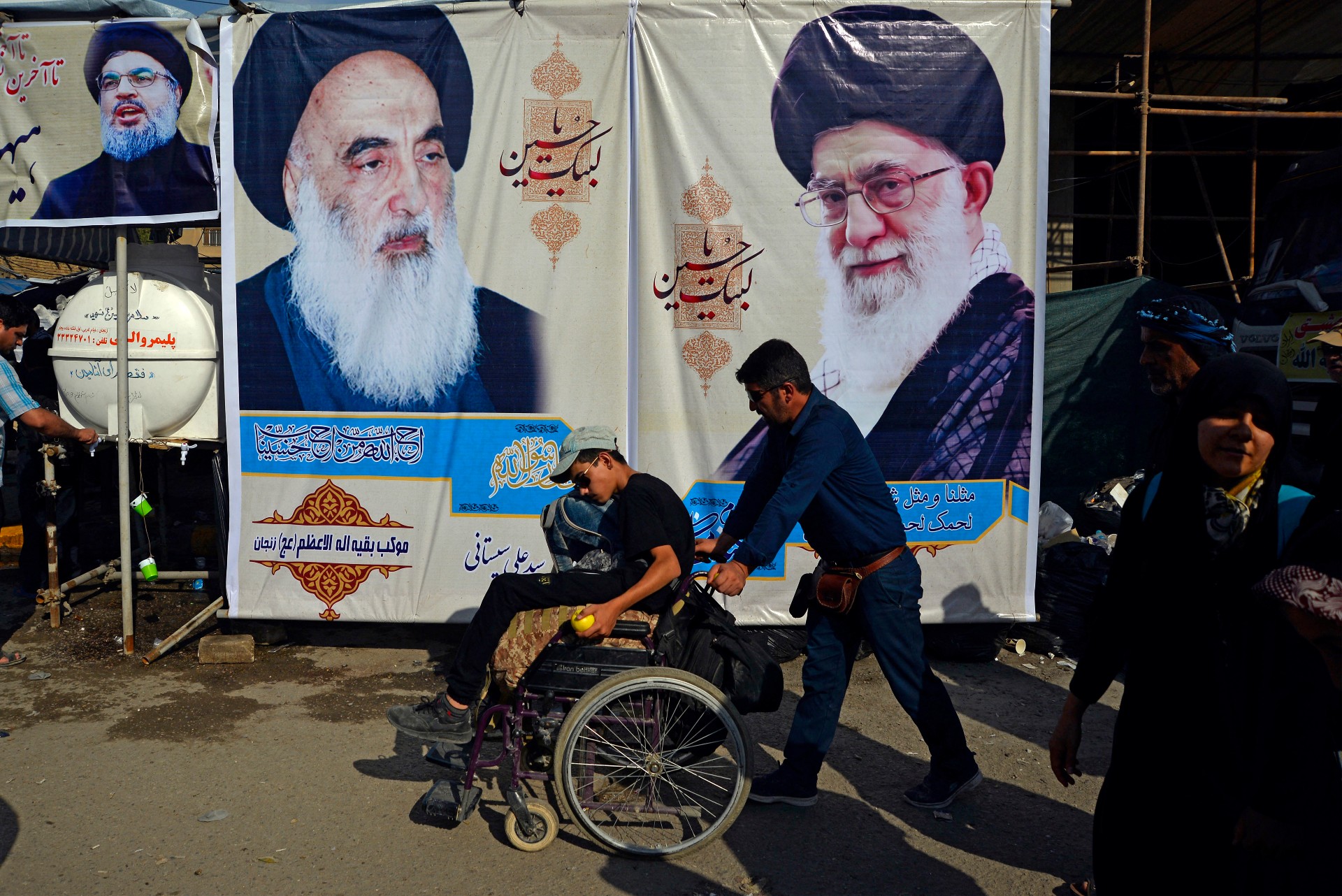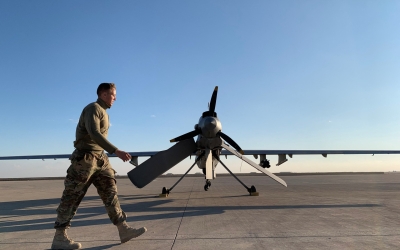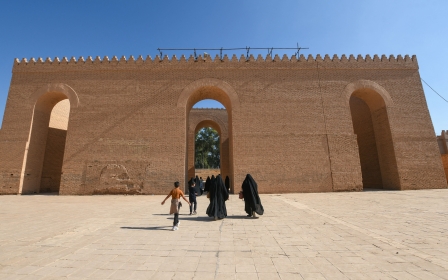Iraq: Iran's competing power centres are creating havoc in the country

The rivalry between Iranian intelligence services operating in Iraq is casting a heavy shadow over the Iraqi security scene, deepening disputes between Tehran's allies and doubling their divisions, commanders, politicians and officials told Middle East Eye.
Since the US invasion in 2003, Iraq has been a major battleground between world and regional powers, especially Iran and the United States. Iran, above all, has built a powerful network of political, religious and armed groups that make Tehran's influence in the country supreme.
That network has for a decade-and-a-half been used to materialise Iran's will. But what happens when Iran's allies and proxies receive conflicting instructions from Tehran? Recent days have revealed that very prospect.
Iranian policy is transmitted in Iraq through four intelligence services. One is handled by the Ministry of Intelligence and National Security.
'There has been an escalation at various levels in Iraq, on the security, political and media levels'
- Iranian affairs specialist
The second is attached to Beit Rahbari, a department that handles particularly sensitive affairs for Supreme Leader Ali Khamenei.
The third is linked to the Revolutionary Guard, while the fourth is affiliated with the supreme leader's office.
The last three answer directly to Khamenei and his closest aides, Iraqi politicians and officials close to Iran told MEE.
Each of these agencies controls dozens of Iraqi armed factions, political and security leaders, and media and religious institutions. Although the work of these agencies mainly relies on the Shia forces, they also work to attract and recruit Sunni, Kurdish, Christian and Yazidi Iraqis.
Over the past two weeks their activities have increased. And, as they have, the agencies' different orientations, visions and goals have blatantly surfaced.
"There has been an escalation at various levels in Iraq, on the security, political and media levels," a specialist in Iranian affairs told MEE, speaking on condition of anonymity.
While the intelligence ministry's agents are urging calm, those answering to Khamenei are stirring the pot. And though those loyal to the supreme leader are all seeking to please him, their approaches and methods can wildly diverge.
This presents a danger for Iraq, as tensions between Tehran and Washington ramp up over potential negotiations to return the US to the 2015 nuclear deal.
"The Iranians believe that the new US administration is weak, and therefore they press [by striking the American forces and the Iraqi government] to force the Americans to return to the nuclear agreement and lift economic sanctions on Iran before starting any negotiations," the specialist said.
"They want to present the decision to lift economic sanctions as a victory, so they put more pressure on the Americans to formally announce the lifting of these sanctions before starting any negotiations."
Iran losing control
Overseas intelligence operations are primarily meant to be the reserve of Iran's Ministry of Intelligence and National Security. But the Revolutionary Guard Corps, in particular its elite Quds Force unit, is by far Iran's most influential arm internationally, due to its direct association with the supreme leader's office.
The Revolutionary Guard's grip on foreign affairs was cemented by Qassem Soleimani, the Quds Force leader killed in a January 2020 US drone strike in Baghdad. Sources said the general did this at the expense of all other intelligence agencies. All Iran-backed political and armed factions answered to him, they said.
The situation has changed dramatically since Soleimani's assassination, however.
In the Islamic State (IS) group, Soleimani found a huge challenge and an equally huge opportunity. The Iraqi military dramatically collapsed in June 2014 when the militant group swept through stretches of northern and western Iraq.
The result was catastrophic and precipitated a conflict that took four years and has left Iraq reeling. But the army's collapse also provided a real and historic chance to form a strike force with defined loyalty, goals and leadership to achieve the required balance between the great forces operating in Iraq, Iraqi politicians told MEE.
When Grand Ayatollah Ali al-Sistani called on Iraqis to take up arms and mobilise against IS, he unintentionally offered an ideological umbrella to form this force.
Soleimani, the most cunning and experienced Iranian field commander in the region, pounced on this opportunity in cooperation with his Iraqi partners, and the result was the establishment of the Hashd al-Shaabi paramilitary umbrella group, whose Iranian-backed Shia factions represented the backbone of its forces.
Under Soleimani, Hashd al-Shaabi played a major role in wiping out IS in Iraq. After the militants' 2017 defeat, disputes began to surface between the paramilitaries, as some of the Iran-backed factions attempted to exploit their successes and behaved as if they were above the state and law.
Yet they remained under Soleimani's control until 3 January 2020, when he and Abu Mahdi al-Muhandis, the godfather of most Iraqi armed factions, were killed.
'A large, uncontrolled mess'
Those assassinations, sources said, left behind a vast mess that has been directly and clearly reflected on the work of the four Iranian intelligence agencies, and the armed factions and political forces associated with them.
"Soleimani was the link that binds all the factions and political forces together, but the Americans killed him and also killed Muhandis, whose presence could mitigate the existing divisions," the specialist said.
"The Iranians have failed to compensate for the two so far, and the result is a large, uncontrolled mess."
'Soleimani was the link that binds all the factions and political forces together, but the Americans killed him and also killed Muhandis, whose presence could mitigate the existing divisions'
- Iranian affairs specialist
According to sources, different armed and political factions have subsequently tied themselves to differing Iranian agencies.
"So disagreements inside Iran have been reflected on the performance of these factions and forces in Iraq," the specialist said.
The weakness of General Esmail Qaani, who succeeded Soleimani as leader of the Quds Force, his lack of the same strong ties with Iraqi leaders, and his more limited powers have opened the door wide for the return of the Iranian Ministry of Intelligence and other agencies to work in Iraq.
Seeing control of the armed factions slipping from Qaani's hands over recent months prompted Khamenei to encourage the Beit Rahbari agency to intervene, sources said.
Asghar Hejazi, Khamenei's security adviser in charge of the Beit Rahbari agency, became directly responsible for the most prominent Iraqi armed factions, including Kataeb Hezbollah and Asaib Ahl al-Haq.
"Qaani is the weakest link. The [Iraqi armed] factions' leaders do not place any weight on him and are not afraid to violate his orders," a political leader close to Iran told MEE.
"The actual leader of the factions at the moment is Hejazi. When he wants something from them, he asks them to go to a meeting with him in Khamenei's office [in Tehran]."
According to the political leader, Iran has been struggling to find someone capable of filling Soleimani's shoes.
"The supreme leader is trying to regain his control over the agencies operating in Iraq and the local forces associated with them, to unify decisions and limit the damage resulting from this chaos," he said.
More divisions
The extent of these divisions was made apparent in the aftermath of a 26 February US air strike on Kataeb Hezbollah and Kataeb Sayyid al-Shuhada fighters in Syria near the Iraqi border.
Despite the attack killing one fighter and wounding three more, most Iran-backed Iraqi armed factions remained silent, while the Hashd al-Shaabi leadership called on the government to investigate whether the raid happened on Syrian or Iraqi soil.
As the Iraqi Military Operations Command sent a committee to the border to investigate the situation, Hejazi called Hashd leader Abu Fadak and a number of prominent Iraqi faction commanders to "an urgent" meeting in Tehran. At the same time, Lebanese Hezbollah leader Hassan Nasrallah invited commanders of a number of smaller factions to another meeting in Beirut.
Although both meetings were held at roughly the same time on 28 February, their outcomes were different. While Nasrallah recommended calm and no escalation against the US forces and Iraqi government, the Tehran meeting urged the opposite, commanders familiar with the outcomes of the two meetings told MEE.
Since the voice of the agencies associated with Khamenei's office is the loudest and most influential, the Tehran commands won over, and the faction leaders represented in the "the Coordinating Body of the Resistance Factions" met the next day in Baghdad to plan the next steps.
The decision to escalate was quickly translated into a missile attack on 3 March targeting the Ain al-Assad military base in western Anbar province, which hosts the largest US military presence. The Iraqi military said the attack did not cause any casualties, but the Pentagon said the next day that a US contractor had died during the raid from a heart attack.
At the same time, an intense media campaign against the Iraqi government was launched by media outlets affiliated with the Iranian-backed forces, alleging that Prime Minister Mustafa al-Kadhimi was seeking to increase the number of US troops in Iraq and provide cover by extending their stay as part of a Nato mission.
'The Nato mission is currently limited to training the defence ministry forces, but we have requested that they train the interior ministry forces and the rest of the security services as well'
- Source close to national security adviser
Kadhimi had to contain the issue and calm the situation before things got out of control. National Security Adviser Qassem al-Araji held a series of meetings with prominent political leaders and commanders of armed factions to "clarify the truth of the matter and the nature of the agreement that the Iraqi government seeks to sign with Nato," a source close to Araji told MEE.
Last week, Araji attempted to bring clarity with a statement: "The number of Nato mission personnel is 320, and they are experts, advisers, trainers and employees, and the mission does not carry out any combat or security missions in Iraq.
"The tasks of the Nato mission in Iraq are limited to training and consulting only, and there is no decision or directive [issued] by the Iraqi government [requiring] to increase their number or change their advisory duties."
Though the statement suggests that the Iraqi government does not intend to increase the Nato numbers, in fact Baghdad was actually negotiating with the alliance's leadership to expand its objectives, especially with regard to training and overhauling the security services, the source close to Araji said.
"The Nato mission is currently limited to training the defence ministry forces, but we have requested that they train the interior ministry forces and the rest of the security services as well," the source said.
"Expanding their mission requires increasing the number of their members and signing a new agreement with them, but they are only here for training and advice and have nothing to do with any combat missions."
Kadhimi the firefighter
Before the whirlwind around Nato and its future in Iraq could subside, the country was hit by a fresh calamity.
On 8 March, a grenade which security officials said had been laid as a trap exploded in a dump near Baghdad's Imams Bridge, which links the northern Sunni-dominated district of Adhamiya and the neighbouring Shia-dominated area of Kadhimiya.
The blast hit Shia pilgrims commemorating the anniversary of the martyrdom of Imam Musa al-Kadhim, killing one and wounding eight.
Such incidents are far from rare in Iraq, yet this attack prompted scores of Facebook and Twitter accounts linked to Iran-backed groups to publish sectarian comments in unison, accusing the people of Adhamiya of targeting Shia pilgrims.
The comments recalled the tragic mass crush that took place at the same place at the same time in 2005, when about 2,000 Shia pilgrims either drowned or died after being trampled on after a rumour broke out that there was a suicide bomber among them.
Hours after the grenade attack, Kadhimi went to the Baghdad operations command headquarters and held a security meeting with the interior minister, the deputy commander of joint operations, the commander of Baghdad operations and a number of military and security officers.
He directed the gathered officers "to exert utmost attention and willingness to ensure the flow of the visit ceremonies," a statement distributed by his office on Tuesday read.
"It was clear that the fronts [against the government] were opening one after the other. Kadhimi was like a firefighter; whenever he closed a source of fire, another door opened," a prominent Shia political leader close to Kadhimi told MEE.
"Many local, regional and international parties have been put on alert to rectify the consequences and calm the situation."
While Araji negotiated directly with the leaders of the armed factions in Baghdad, Kadhimi, his team and some political leaders were in constant contact with Beirut, Tehran, the United Nations mission and other power centres, sources familiar with the negotiations told MEE.
On Wednesday, the efforts resulted in the major armed factions agreeing to calm and stop attacks against US forces and their allies inside Iraq in exchange for Kadhimi, as commander in chief of the armed forces, submitting a written request to the UN Security Council to terminate the mission of the US-led coalition forces, provided that they withdrew within a maximum period of 12 months.
This crisis will not be the last
Though significant, that truce agreement will not put an end to the conflict between the US and Iran on one hand, nor the armed factions and the Iraqi government on the other.
The crisis of the past two weeks was not the first and it will not be the last, Iraqi officials told MEE.
Over recent weeks attacks on US targets in Iraq have been claimed by small armed groups bearing names never seen before, such as the "guardians of blood" and the "people of the cave".
It is a new tactic adopted by well-known factions to carry out attacks without bearing the consequences, officials said.
'The Iranian agencies are playing a game of good cop/bad cop with the Americans and the Iraqi government. This tactic always pays off'
- Iranian affairs specialist
Although these attacks are limited in effect, they are irritating and embarrassing for the Iraqi and US governments, and cause casualties from time to time.
"All of these [new] groups are fake and do not exist. Those attacks have been carried by the known factions, but they do not want to bear the consequences so they attribute them to imaginary groups," the specialist said.
"The invention of the existence of these groups provides the armed factions and the Iranians with the required space to manoeuvre and move between trenches and disavow responsibility for this or that attack."
The specialist noted that occasionally conflicting messages coming out of Iran can actually serve Tehran's purposes, and be part of a broader strategy.
"The Iranian lines [agencies] are good at playing the game of manoeuvre. While one of the lines denies its connection to this attack, another line claims responsibility for it," he said.
"They are playing a game of good cop, bad cop with the Americans and the Iraqi government. This tactic always pays off."
Middle East Eye propose une couverture et une analyse indépendantes et incomparables du Moyen-Orient, de l’Afrique du Nord et d’autres régions du monde. Pour en savoir plus sur la reprise de ce contenu et les frais qui s’appliquent, veuillez remplir ce formulaire [en anglais]. Pour en savoir plus sur MEE, cliquez ici [en anglais].







